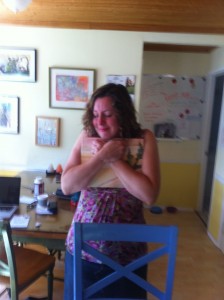Groundhog’s Dilemma is here!
 It’s self-indulgent, but I can’t resist; my December pick is my new picture book that just hit the shelves, Groundhog’s Dilemma! It’s gorgeously illustrated by award-winning author/illustrator Matt Faulkner (with whom I’m about to celebrate five years of wedded bliss.)
It’s self-indulgent, but I can’t resist; my December pick is my new picture book that just hit the shelves, Groundhog’s Dilemma! It’s gorgeously illustrated by award-winning author/illustrator Matt Faulkner (with whom I’m about to celebrate five years of wedded bliss.)
Half of Groundhog’s friends want him to predict an early spring, and the other half want a longer winter. Groundhog wants to please everyone, so when February 2nd comes, Groundhog has a dilemma: to see or not to see his shadow?
Because the characters in this book have strong opinions and are trying to persuade our hero Groundhog (who is not immune to the lures of membership on a team or blueberry pie), use Groundhog’s Dilemma as a springboard for writing an opinion piece. I have a free, printable page on my website so students can write a persuasive letter to Groundhog (Core Writing Standard #1? Check!). Kids who send letters to Groundhog via my email or snail mail will receive responses!
Want more free? You’ll find printable puppets perfect for retelling the story, a comprehension chart, and fun facts on kristenremenar.com. I hope you enjoy it as much as these kiddos do!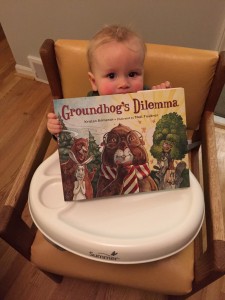
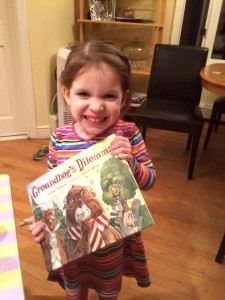
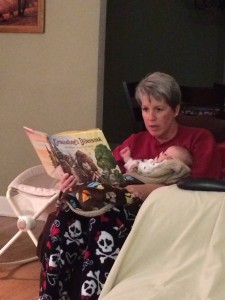
“One Family” is one you need for Thanksgiving!
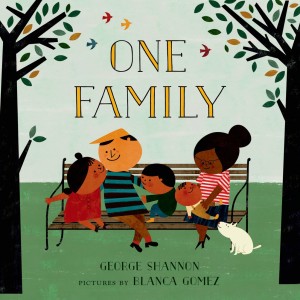 Thanksgiving is my favorite holiday, but it’s a challenge to find Thanksgiving picture books that connect with kids (I find many “pilgrim and Indian” books that are cringeworthy with stereotypes). This year, I’m focusing on the “thanks” in Thanksgiving and sharing One Family by George Shannon with pictures by Blanca Gomez.
Thanksgiving is my favorite holiday, but it’s a challenge to find Thanksgiving picture books that connect with kids (I find many “pilgrim and Indian” books that are cringeworthy with stereotypes). This year, I’m focusing on the “thanks” in Thanksgiving and sharing One Family by George Shannon with pictures by Blanca Gomez.
The simple counting book is elevated here to show the beauty of what a family can be.
Counting up to ten, we see all kinds of inclusive loving groups: two dads and their daughter (all with different shades of skin), grandparents and kids, a family where the dad and his sons are wearing turbans, a mix of adults and kids where it’s not clear what the relationships are but who cares because they’re smiling and together. On the last page showing all the people we read, “One is one and everyone. One earth. One world. One family.”
Use this book to inspire your students to write and draw about their own families. To continue the counting 1 to 10 structure, students can write about what they are thankful for this holiday. Pair this with the wonderful new nonfiction book Families by Shelly Rotner and Sheila M. Kelly if you want to compare and contrast to hit the Integration of Knowledge & Ideas standard. I count you among my many blessings!
Read More27 Books You Can Use This Year
During the “Moving Beyond the Basics… Reaching for More” conference on Aug. 11 at the Byron Center High School in Michigan, a roomful of teachers and I read through boxes of books. (Thank you, Annemarie Johnson and Kate DiMeo, for inviting me to share informational picture books and to talk about kids’ book publishing.) ((Have I mentioned that my first picture book, GROUNDHOG’S DILEMMA, will come out this December 1 from Charlesbridge?)) After browsing and brainstorming, we generated a list of 27 books with lesson ideas we can use this year in kindergarten through third grade. Feel free to share it!
| Title | Author | Illustrator | Lesson Ideas |
| Alphabeasties and Other Amazing Types | Werner Sharon | Forss, Sarah | alliteration, identifying letters in different fonts – visual learners |
| Aunt Ant Leaves through the Leaves | Coffelt, Nancy | homonyms/homophones | |
| Bee Dance | Chrustowski,Rick | vocabulary, informational reading, chronological text structure, debate if it is “narrative” or “informative” | |
| The Best of Times | Tang, Greg | Briggs, Harry | multiplication in third grade, rules for each and tables |
| Boy, Were We Wrong About the Weather! | Kudlinkski, Kathleen V. | Serra, Sebastia | compare/contrast what we once thought to what we now think, text features, weather in first grade, landforms in second |
| Families | Rotner, Shelley | Rotner, Shelley | “all about” writing at a simple level = great mentor text |
| Greedy Apostrophe: a cautionary tale | Carr, Jan | Long, Ethan | grammar – ways to use an apostrophe |
| Henry’s Map | Elliot, David | mapping skills lesson, pictures with labels = text feature, mentor tex for writing | |
| How To Surprise a Dad | Reagan, Jean | Wildish, Lee | mentor text for “how to” writing that goes beyond basic instruction format, mentor text for incorporating all five senses in details |
| In Mary’s Garden | Kugler, Carson | Kugler, Tina | compare/contrast with “The Most Magnificient Thing” |
| The King Who Rained | Gwynne, Fred | homonyms/homophones/word play, figurative language | |
| Lucky and Stu vs. the Mikanikal Man | Van Wright, Cornelius | reading for pleasure! Friendship themes and good “boy” book | |
| Math Fables | Tang, Greg | Cahoon, Heather | number sense for youngers |
| Me, Too! | Dunklee, Annika | Smith, Lori Joy | opinion writing: “Reason #1”, friendship story to discuss |
| Messy Jesse | Bowles, Paula | writing prompt, “what I’m good at”, punctuation lesson | |
| Nino Wrestles the World | Morales, Yuyi | using context to decode unfamiliar words, appreciation of other languages/cultures | |
| One Boy | Seeger, Laura Vaccaro | finding words within words | |
| One Word from Sophia | Averbeck, Jim | Ismail, Yasmeen | persuasive writing, writing for an audience, text features like glossary |
| Ostriches Are Not Pets! | Niver, Heather Moore | persuasive writing | |
| Over in the Wetlands | Rose, Caroline Starr | Dunlavey, Rob | vocabulary – word choice and author’s craft, context clues, inferring, how do animals prepare for storms compared to how people prepare? |
| Rufus Goes to School | Griswell, Kim T. | Gorbachev, Valeri | use at the beginning of the school year, shows importance of learning how to read, point out persuasive reasons why pigs should (not) go to school |
| Simple Machines | Adler, David A. | Raff, Anna | use as a mentor text for flip books, compare/contrast, nonfiction with illustrations and not photos, text features, easy nonfiction that’s not about animals |
| Speed, Speed, Centipede! | Dahl, Michael | Trover, Zachary | early math counting by tens, shows 10 frames |
| This Plus That: Life’s Little Equations | Rosenthal, Amy Krouse | Corace, Jen | writing with math symbols |
| Water is Water | Paul, Miranda | Chin, Jason | “show, don’t tell”, art tells story as much as text does |
| Wumbers | Rosenthal, Amy Krouse | Lictenheld, Tom | lesson on speech bubbles |
| Zero the Hero | Holub, Joan | Lictenheld, Tom | higher math concepts, friendship, lesson on speech bubbles |
The winner is: You Are (Not) Small!
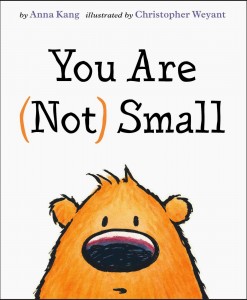 Happy Book Award Season! Many of us look forward to the annual announcement of the Caldecott and Newbery Medal Awards from the American Library Association, but the one that made me hoot and holler loudest this year was the announcement of the winner of the Theodor Seuss Geisel Award for the most distinguished beginning reader book: You Are (Not) Small written by Anna Kang and illustrated by Christopher Weyent.
Happy Book Award Season! Many of us look forward to the annual announcement of the Caldecott and Newbery Medal Awards from the American Library Association, but the one that made me hoot and holler loudest this year was the announcement of the winner of the Theodor Seuss Geisel Award for the most distinguished beginning reader book: You Are (Not) Small written by Anna Kang and illustrated by Christopher Weyent.
Fantastic “easy” reader? Check.
Great for Readers’ Theater? Check.
Funny ending? Check.
Works for a ton of tie-in lessons? Check.
Story and art that kids will want to return to again and again? Big ol’ check!
Finding mentor texts on expressing opinion, giving reasons, persuasion, etc. isn’t easy for the younger crowd, so if you teach kindergarten – third grade, grab You Are (Not) Small. (It’s also fantastic for a print concepts lesson on italics, ellipses, underlining, for a lesson on reading with expression, for a math/science tie-in for comparing items by size, but I digress.)
The two main characters in this book express clear, opposite opinions. The orange fuzzy creature tells the purple fuzzy creature, “You are small.” The purple fuzzy disagrees, “I am not small. You are big.” Back and forth they go, giving reasons for their opinion by comparing themselves to other fuzzy creatures. It’s so simple it’s brilliant, and the ending will get everyone giggling.
After reading this to a first grade class, I told them, “You are small.” Uproar ensued. “No, we aren’t!”
“Yes, my opinion is that you are small, and my reason is that you are all smaller than this bookshelf.”
“But we’re bigger than the chair!” “Yes, and we’re taller than the desk!”
This led to an easy quick-write session: choose an opinion statement of “I am big” or “I am small” and write three reasons to support your opinion. Go!
So grab You Are (Not) Small by Anna Kang and Christopher Weyant, and check out other winners of the Theodor Seuss Geisel Award. The Caldecott and Newbery Medals are wonderful, but they aren’t the only awards given by ALA, so explore lists like the Coretta Scott King Awards and treat yourself to award-winning books.
Read More




